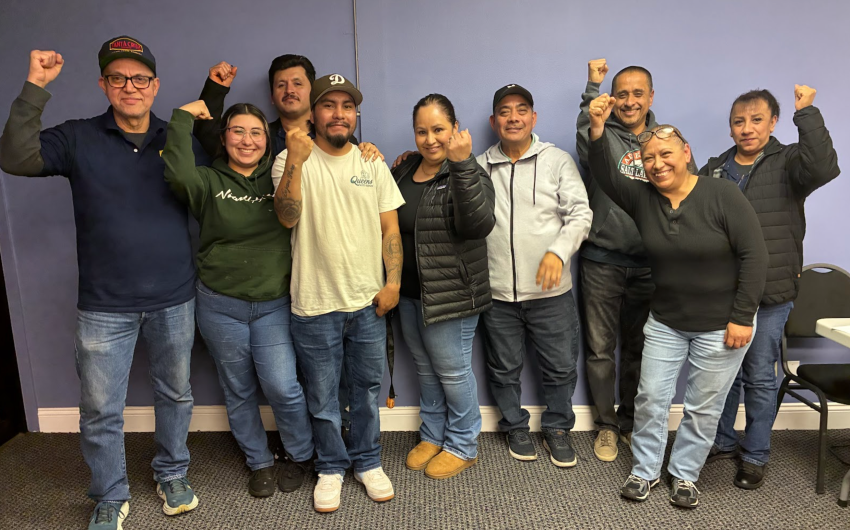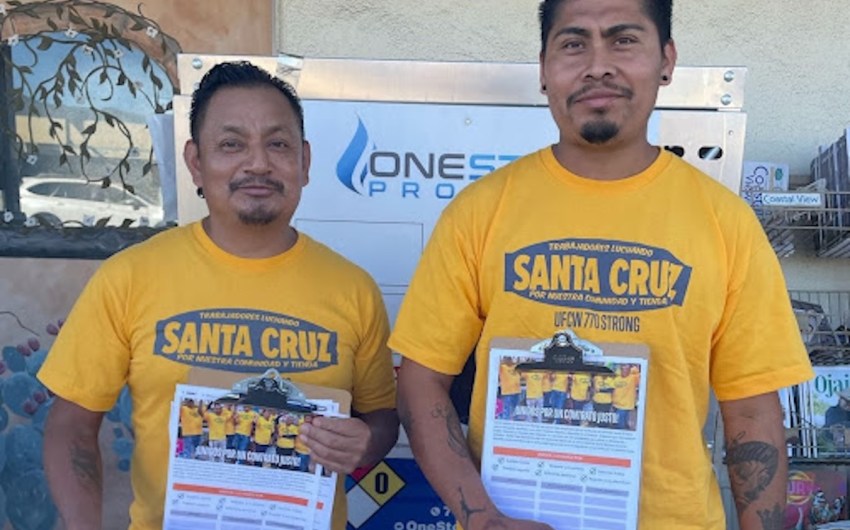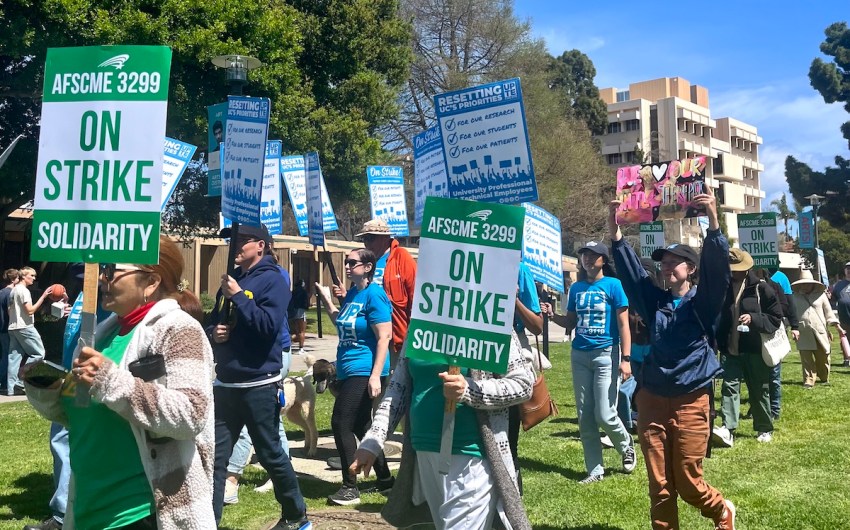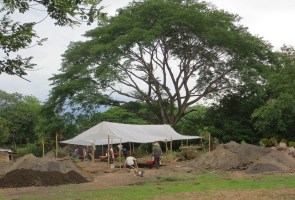Last week, dozens of farmworkers and advocates representing the Alianza Campesina de la Costa Central, a partnership between two organizations — Central Coast Alliance United for a Sustainable Economy (CAUSE) and Mixteco Indigena Community Organizing Project (MICOP) — showed up to the County Board of Supervisors hearing to share their personal stories of financial hardships during the public comment period, and to ask the board to agendize the topic of a wage ordinance for a future meeting.
The Alianza Campesina was formed as a way for farmworkers on the Central Coast to organize and advocate for themselves, in part inspired by the decades-long fight for workers’ rights and by the deaths of two farmworkers — Jose Velásquez and Rosa Sanchez — who were both tragically killed in work-related accidents in a two-week span last September. Earlier this year, the group released a report detailing the struggles of farmworkers in Santa Barbara County, who, according to the report, continue to work for wages that remain “stubbornly low” despite consistent inflation and increases in the costs of basic necessities.
One second-generation farmworker, Blanca Antonio Aquino, said that her family and the families of many of her coworkers live under a different type of “normal,” which requires shopping at secondhand stores and garage sales and relying on food distribution events to put food on the table. This strain is especially hard on the children of farmworkers, she added, as there is often not enough money for them to participate in after-school activities like their schoolmates from wealthier homes.
“Let us not put a price tag and expiration date on the health and well-being of our farmworkers who work tirelessly and laborfully to provide us with fresh produce,” she said. “Instead, let’s provide our community of farmworkers with the means and resources to live with a dignified wage instead of forcing them and their families to simply survive.”
Hazel Davalos, co-executive director of CAUSE, urged the board to support a higher minimum wage for farmworkers. Doing so would ensure that the county was following through on improving working conditions for Central Coast agricultural workers — something CAUSE and the county have both been working towards for years.
“Despite our efforts,” Davalos said, “if you ask any farmworker in our country what’s the biggest challenge they face, it’s low wages.”
She said that during Alianza Campesino meetings, workers have opened their hearts to share their struggles about dangers of working, recent farmworker deaths, and the “hurt of being called essential workers yet being paid and treated like they’re disposable.”
Farmworker advocates are asking that the board look into a $26 minimum wage — a number that they feel is commensurate with the workload and potential health risks like extreme heat and exposure to dangerous pesticides. The higher wages could also, they argue, encourage consumers to buy local produce and support businesses they know are paying a proper wage.
“We can do this,” Davalos told the board. “With a single policy, you as a board can lift thousands of families in our county out of poverty.”
Representatives of growers, on the other hand, are worried that the push for higher wages will cause a host of unintended consequences.
Claire Wineman, president of the Grower-Shipper Association of Santa Barbara and San Luis Obispo Counties, said that the $26 guarantee would not properly reflect the take-home income for workers whose pay is based on production. A countywide requirement for higher pay, she added, could lead to a loss of jobs in the county, “further distancing our local community from neighboring counties — not to mention Arizona and Mexico — as growing regions.”
“We will continue to pay the most competitive wages that we can while also staying in business,” she said. “Significant year-after-year increases in the minimum wage cannot be sustained. Agriculture is already difficult enough; let us not open this Pandora’s box.”
Several boardmembers, however, were inspired by the farmworkers’ willingness to speak up during public comment.
Supervisor Laura Capps said she was “incredibly moved by the testimonies” heard during the meeting. “Their pleas for better wages are powerful and compelling,” she said, “as is the report that CAUSE has done.”
In her Labor Day letter to constituents, Capps wrote: “Today, I am particularly mindful about farmworkers and the many unseen ways in which their hard work shapes our community and economy.… Their essential work, frequently overlooked and undervalued, deserves our recognition and appreciation. I am grateful to CAUSE and MICOP for amplifying their voices.”
In Santa Barbara County, which is the number-one producer of strawberries in the nation, she added, workers typically see just about 28 cents per box — about 7 percent of the total price.
Supervisor Das Williams said he had his “conscience stirred by the farmworkers,” and that he has joined with Supervisor Joan Hartmann to take the lead and ask staff to prepare for an item to be agendized for a future meeting, where the board will look into the details and create direction for a committee on the issue.
Supervisor Hartmann said that the agricultural industry, which is estimated to make about $1.8 billion a year, is “critically important,” and she hopes that the board can “understand the dynamics and how some people are left behind.”
Click here to read the Alianza Campesinos’ full report, Harvesting Dignity: The Case for a Living Wage for Farmworkers.
Premier Events
Sun, Jan 11
3:00 PM
Santa Barbara
Mega Babka Bake
Fri, Jan 23
5:00 PM
Santa Barbara
Divine I Am Retreat
Mon, Jan 05
6:00 PM
Goleta
Paws and Their Pals Pack Walk
Mon, Jan 05
7:00 PM
Santa Barbara
Ancient Agroecology: Maya Village of Joya de Cerén
Tue, Jan 06
7:00 PM
Santa Barbara
Amazonia Untamed: Birds & Biodiversity
Wed, Jan 07
7:30 PM
Santa Barbara
SBAcoustic Presents the John Jorgenson Quintet
Thu, Jan 08
5:30 PM
Santa Barbara
Blueprints of Tomorrow (2026)
Thu, Jan 08
6:00 PM
Isla Vista
Legal Literacy for the Community
Thu, Jan 08
7:30 PM
Santa Barbara
Music Academy: Lark, Roman & Meyer Trio
Fri, Jan 09
8:00 AM
Santa Barbara
Herman’s Hermits’ Peter Noone: A Benefit Concert for Notes For Notes
Fri, Jan 09
6:00 PM
Montecito
Raising Our Light – 1/9 Debris Flow Remembrance
Fri, Jan 09
6:00 PM
Santa Barbara
Ancestral Materials & Modernism
Sun, Jan 11 3:00 PM
Santa Barbara
Mega Babka Bake
Fri, Jan 23 5:00 PM
Santa Barbara
Divine I Am Retreat
Mon, Jan 05 6:00 PM
Goleta
Paws and Their Pals Pack Walk
Mon, Jan 05 7:00 PM
Santa Barbara
Ancient Agroecology: Maya Village of Joya de Cerén
Tue, Jan 06 7:00 PM
Santa Barbara
Amazonia Untamed: Birds & Biodiversity
Wed, Jan 07 7:30 PM
Santa Barbara
SBAcoustic Presents the John Jorgenson Quintet
Thu, Jan 08 5:30 PM
Santa Barbara
Blueprints of Tomorrow (2026)
Thu, Jan 08 6:00 PM
Isla Vista
Legal Literacy for the Community
Thu, Jan 08 7:30 PM
Santa Barbara
Music Academy: Lark, Roman & Meyer Trio
Fri, Jan 09 8:00 AM
Santa Barbara
Herman’s Hermits’ Peter Noone: A Benefit Concert for Notes For Notes
Fri, Jan 09 6:00 PM
Montecito
Raising Our Light – 1/9 Debris Flow Remembrance
Fri, Jan 09 6:00 PM
Santa Barbara
























